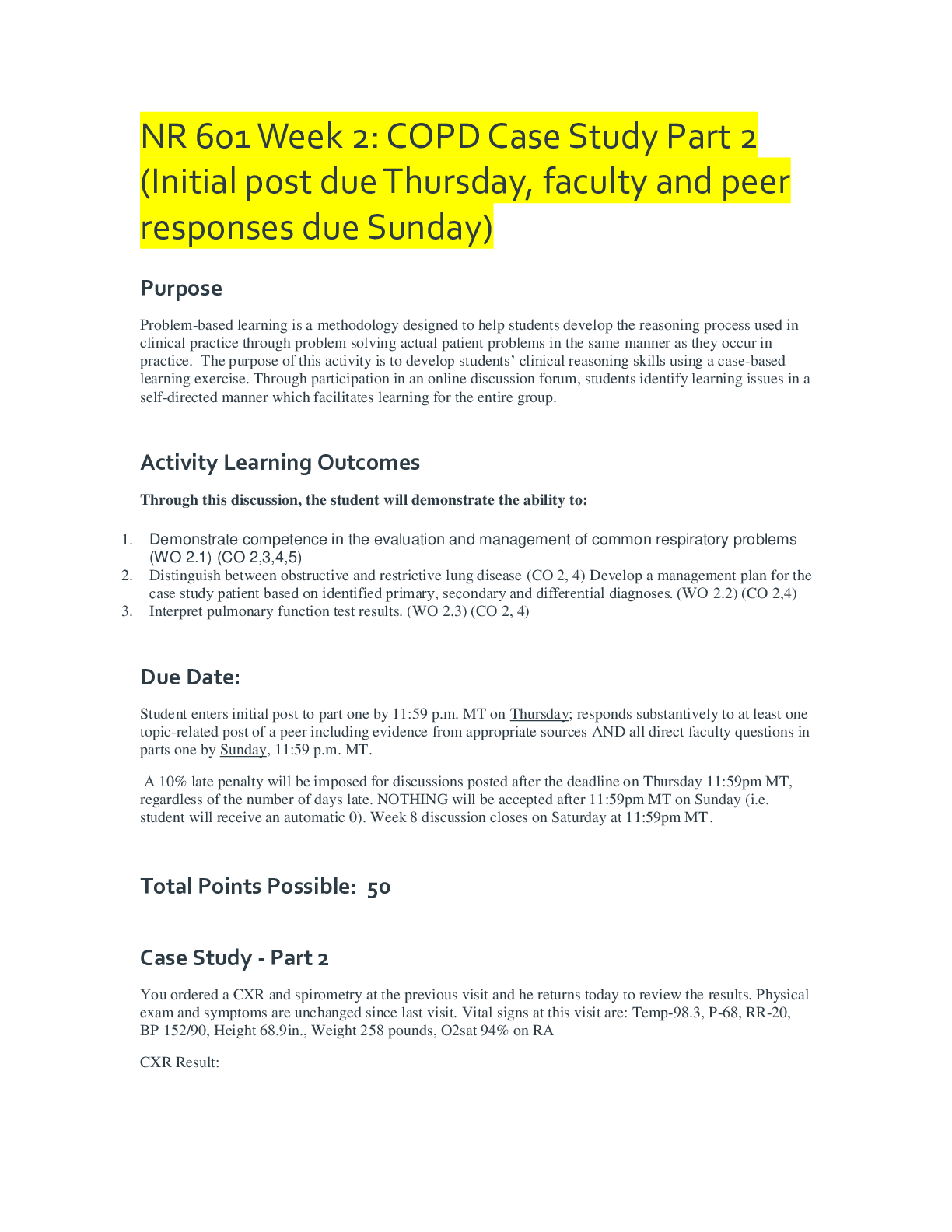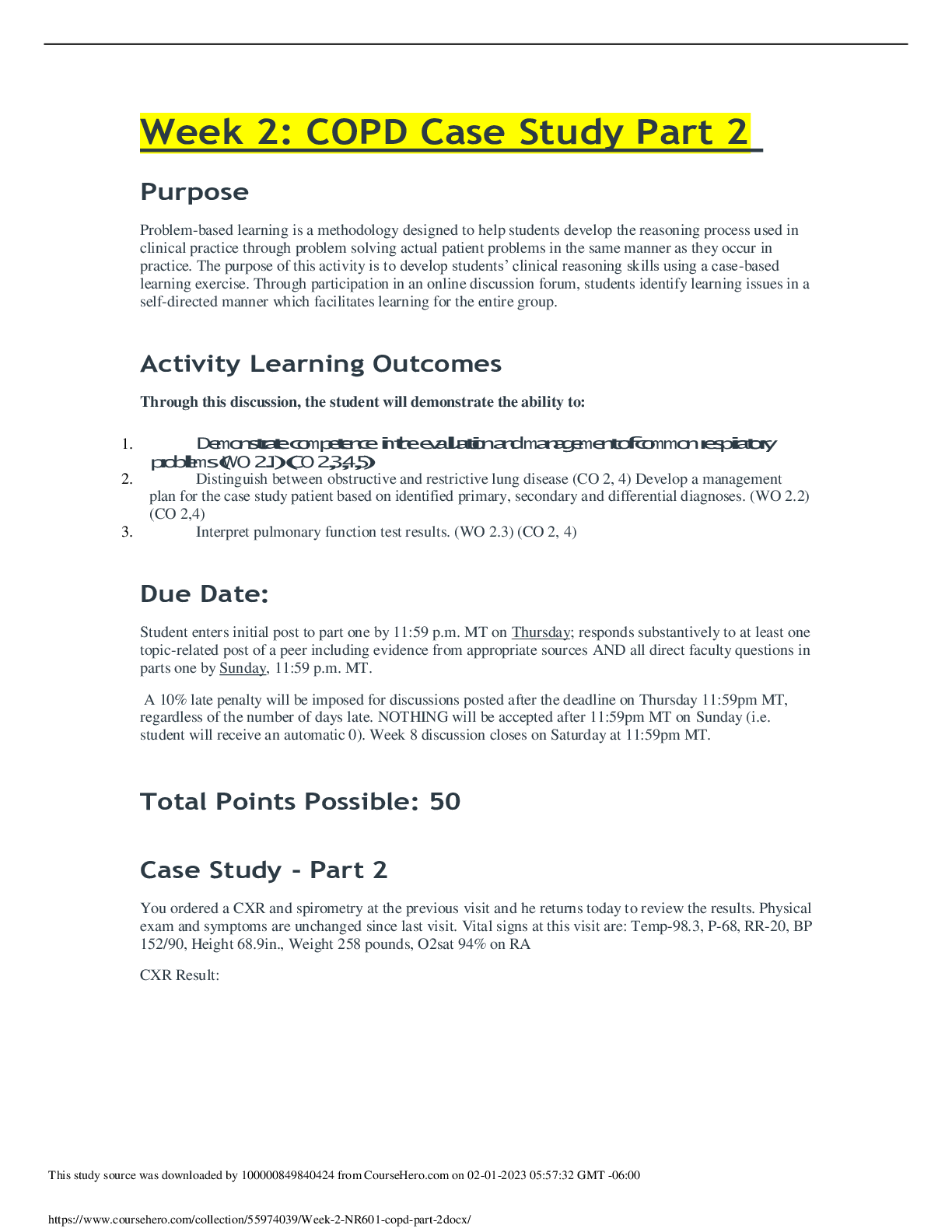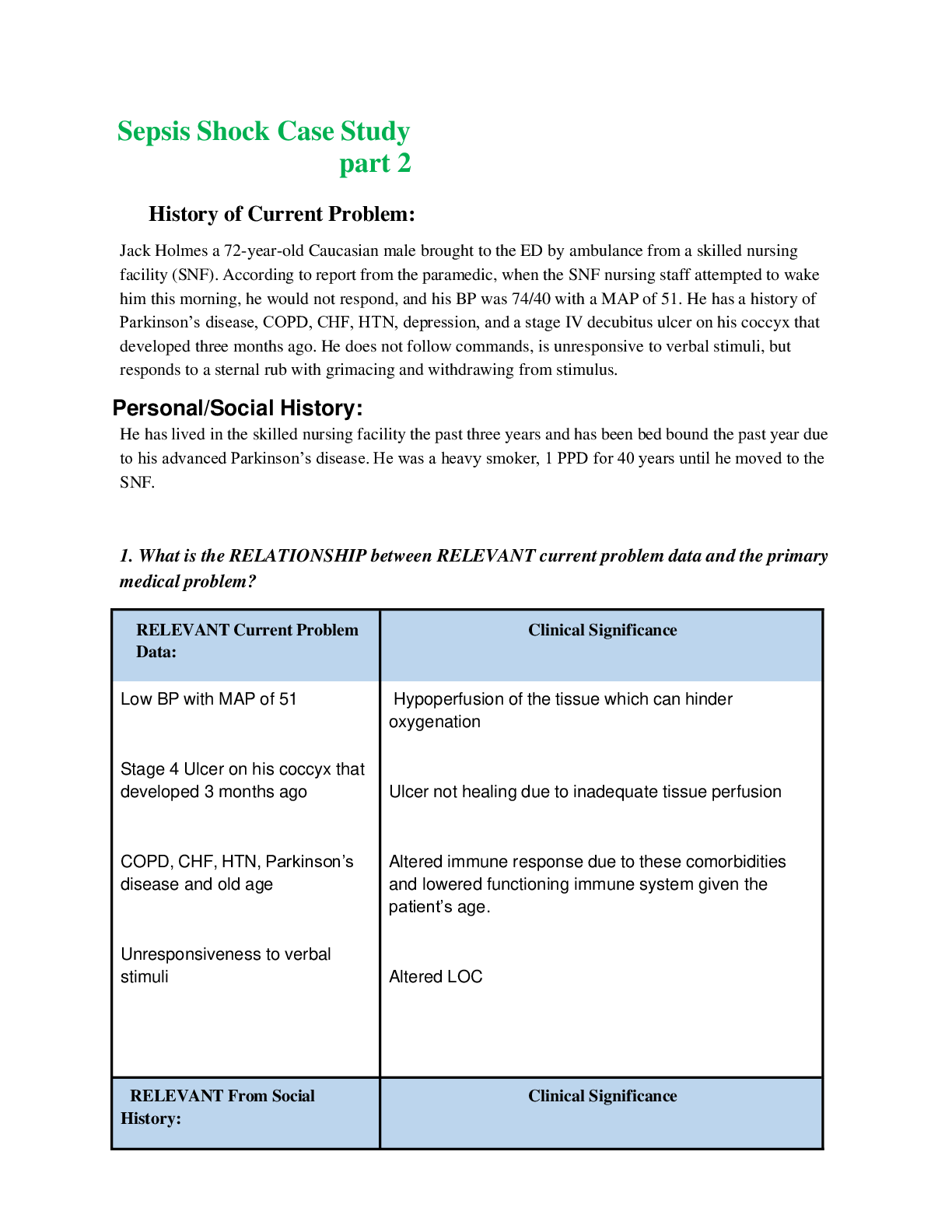*NURSING > CASE STUDY > DKA Case Study part 2 (All)
DKA Case Study part 2
Document Content and Description Below
DKA Case Study part 2 DKA Case Study part 2 History of Current Problem: Diana Humphries is a 45-year-old woman with chronic kidney disease stage III and diabetes mellitus type1 who checks her bloo... d sugar daily, or whenever she feels like it. She has been feeling increasingly nauseated the past 12 hours. She has had a harsh, productive cough of yellow sputum the past three days. She checked her blood glucose before going to bed last night and it was 382, but then she fell asleep early and missed her bedtime dose of glargine (Lantus) insulin. When she awoke this morning, she had generalized abdominal pain and continued to feel nauseated and had a large emesis. Her glucometer was unable to read her blood glucose because it was too high. She took 10 units of lispro (Humalog) insulin this morning. Her nausea has increased all morning and she has been unable to eat or keep anything down despite having an increased thirst and appetite. She also has had increased frequency of urination. When her lunchtime glucometer gave no reading because it was too high and out of range, she called 9-1-1 to be evaluated in the emergency department (ED). Personal/Social History: Diana has been inconsistently compliant with her medical/diabetic regimen due to her struggles with anxiety and depression that have worsened since her mother died three months ago. She considers 200 a good blood sugar reading. She is divorced with no children and has been homeless and has lived in a shelter off and on the past month. She is on Social Security disability because of complications related to diabetes. At one point during the intake interview, she expressed to the nurse, “I’m going to die anyway, why does all this matter?” 1. What is the RELATIONSHIP between RELEVANT current problem data and the primary medical problem? RELEVANT Current Problem Data: Clinical Significance Chronic Kidney Disease Type 1 Diabetes and checks BG whenever she feels like it BG 383 before bed and didn’t take her bedtime Lantus Generalized abdominal pain, nausea, emesis Decreased function of the kidneys and if patient is in DKA there is an increased load on kidneys due to polyuria Puts her at risk for developing DKA especially since she doesn’t check her BG regularly BG already high before bed so we know it was high for a while before she called 911 S/S of hyperglycemiaIncreased thirst, appetite, urination Lunchtime glucometer gave no reading because too high S/S of hyperglycemia Severely hyperglycemic RELEVANT From Social History: Clinical Significance Divorced Homeless and lives in the shelter Inconsistent with medication regimen Considers BG of 200 to be good Death of mother Suicidal Ideation Struggles with anxiety and depression Lack of family support Other struggles to deal with on top of her illnesses Non-compliant Lack of education/non-compliance Feeling hopeless which could contribute to her noncompliance Feeling hopeless which could contribute to her noncompliance Can contribute to her non-compliance 2. Past Medical History and Medications Identify the pharmacologic classification and effect for each medication. Then Identify which medication is given for each past medical problem PMH Home Meds Pharm Classification EffectChronic kidney disease stage III (diabetic nephropathy) Anemia Diabetes Mellitus Type I (age 12) Diabetic retinopathy Neuropathy- lower legs Hyperlipidemia Hypertension Coronary Artery Disease GERD Anxiety Depression 1. Aspirin 81mg PO daily 2. Lisinopril 10 mg PO daily 3. Lorazepam 1mg PO bid prn 4. Citalopram 40 PO mg daily 5. Zolpidem 10 mg PO at HS prn 6. Gabapentin 300 mg PO bid 7. Labetalol 200 mg PO bid 8. Omeprazole 20 mg PO daily 9. Simvastatin 40 mg PO HS 10. Glargine insulin 50 units SQ at HS 11. Lispro insulin SQ sliding scale AC and HS 1. NSAID 2. ACE inhibitor 3. Benzodiazep ine 4. SSRI 5. Benzodiazep ine 6. Anticonvulsa nt 7. Beta blocker 8. PPI 9. Statin 10. Insulin 11. Insulin 1. Prevents platelet formation 2. Decreases blood pressure 3. Increases gabapentin (help with anxiety) 4. Increases gabapentin 5. Prevents serotonin reuptake 6. Increases gabapentin (helps with nerve pain) 7. Decreases blood pressure 8. Decreases acid in stomach to prevent stomach ulcers 9. Decreases cholesterol levels 10. Decreases blood glucose levels (long acting) 11. Decreases blood glucose levels (rapid acting)Patient Care Begins Current VS P-Q-R_S-T Pain Assessment T: 101.6 F/38.7 C (oral) Provoking /palliative Coughing and deep breathing/Not coughing P: 114 (regular) Quality Sharp R: 24 (regular/deep) Region/radiation Right chest BP: 102/66 Severity 5/10 O2 Sat: 90% Room air Timing Intermittent 2. What VS data are RELEVANT and must be interpreted as clinically significant by the nurse? RELEVANT VS Data Clinical Significance R 24 (high) T 101.6 ( high) P 114 ( high) O2 sat: 90% Low BP High due to possible lung infection/compensation/pain Could be due to infection and related to the yellow sputum and productive cough Elevated due to the decrease in blood pressure. Low due to her increased RR, productive cough Could be due to beta blockers. Important to monitor if it is out of her normal range. Could be low due to vomiting so related to a volume depletionPain 5/10 Sharp and gets worse with coughing and deep breathing. Could be related to the possible lung infection. Intermittent Current Assessment General appearance Appears anxious and uncomfortable, body tense, occasional grimacing Respirations Breath sounds clear with coarse crackles in RLL, non-labored respiratory effort, harsh productive cough with thick yellow phlegm visualized Cardiac Pink, warm & dry, no edema, heart sounds regular–S1S2, pulses strong, equal with palpation at radial/pedal/post-tibial landmarks Neuro Alert & oriented to person, place, time, and situation (x4) GI Abdomen soft/non-tender, bowel sounds audible per auscultation in all 4 quadrants, nausea is persistent GU Frequency of urination, urine clear in color, denies pain or burning when voids Skin Skin integrity intact, lips dry, oral mucosa dry–tacky .4. What assessment data are RELEVANT and must be interpreted as clinically significant by the nurse? RELEVANT VS Data Clinical Significance General appearance - anxious and uncomfortable, tense, grimacing RR - clear with coarse crackles in RLL, hard productive cough with thick yellow sputum GU - frequent urination, clear in color GI - nausea is persistent Skin - lips are dry and tacky Indicative the patient is in pain. Anxious and uncomfortable are s/s of elevated blood glucose levels Related to an infection. Possibly pneumonia. Symptoms of elevated blood glucose levels. Decrease in concentration could be indicative of just getting rid of fluids and not filtering anything Causing the electrolyte and fluid volume imbalance Indicative of dehydration EKG5. Interpret the EKG – rhythm NSR what abnormalities do you identify: elevated t waves What is the clinical significance of this abnormality? Indicative of hyperkalemia which is associated with acidosis Lab/diagnostic Results: 6. What diagnostic results are RELEVANT and must be recognized as clinically significant to the nurse? Radiology Report: Chest x-ray Relevant Results Clinical Significance Possibly PneumoniaRight lower lobe infiltrate WBC: Hgb: Platelet Neutroph il Bands Current: 15.2 11.8 155 92 3 oldest: 9.8 11.2 162 70 1 7. Address the results of the CBC- address each lab result Relevant Results Clinical Significance Trend (Improve worsening stable) WBC Hgb Platelet Neutrophils Bands Elevated - infection Slightly decreased could Normal (low) Elevated - infection Elevated - infection Worsening Improving Worsening Worsening Worsening Na: Potassiu m: CO2 Bicarb Glucos e BUN Creatinin e GFR Lactat e Current : 122 6.4 11 729 56 2.4 20 2.8 OLD 138 4.2 25 168 42 1.98 38 n/a 8. Address the results of the BMP –address each resultRelevant Results Clinical Significance Trend (Improve worsening stable) Na Potassium CO2 Bicarb Glucose BUN Creat GFR Lactate Decreasing - hypovolemia, hyponatremia from kidneys expelling Increasing - acidosis and can cause arrythmias Decreasing - acidosis Increasing - Hyperglycemia Increasing - decrease in kidney function Increasing - decrease in kidney function Decreasing - decrease in kidney function Increasing - acidosis, body doing anaerobic metabolism Worsening Worsening Worsening Worsening Worsening Worsening Worsening Worsening Worsening UA with Micro Color : Clarit y: Sp. Gr. Protein Glucos e Ketone s Bili Blood Nitrates LET Curre nt: Clear Cloud y 1.005 Positive >1000 Large NEG NEG Neg Neg RBC’ WBC’ Bacteri Epithelis s al al Micro 1 2 Neg Neg 9. Address the results of the UA Relevant Results Clinical Significance Trend (Improve worsening stable) Color Clarity Specific gravity Protein Glucose Ketones Clear - Not concentrated. Sign of hyperglycemia and related to polyuria from osmotic diuresis Cloudy 1.005 Positive >1000 - hyperglycemia Indicative of DKA Not concentrated Due to infection possibly Low because not concentrated and related to polyuria Could be occurring due to the chronic kidney failure DKA Break down occurs when blood glucose levels are high 10. Creatinine 2.4 Normal value 0.7-1.2 Critical value Greater than 1.2 Clinical significance Decrease in kidney function 11. Potassium 6.4 Normal value 3.5-5 Critical value Greater than 5 or less than 3.5 Clinical significance Acidosis - can cause heart arrhythmias 12. What is the Primary PROBLEM ? Diabetic Ketoacidosis13. Present the Pathophysiology of the problem Diabetic Ketoacidosis occurs in type 1 diabetics. This is when there is a significant increase in blood glucose levels due to the lack of insulin. Glucose accumulates in the blood result in the metabolism of ketones. Ketones will then accumulate in the blood resulting in acidosis. The increase in acidosis will then contribute to other complications such as shock and ultimately coma/death. 14. Looking at your orders for Diana – what is the purpose or rationale for each one? Care Providers orders Rationale Blood glucose stat Assess blood glucose levels to manage treatment options 12 lead EKG Monitor heart rhythm due to very high potassium level Place on cardiac monitor Monitor heart rate due to very high potassium level Establish IV and initiate NS 0.9% bolus of 1000 mL To manage fluid volume Ondansetron 4 mg IV push every 4 hours for nausea To help with nausea and vomiting. Prevent further electrolyte imbalances caused by vomiting Hydromorphone 0.5 mg every 4 hours for pain To help decrease pain Regular insulin 10 units IV push stat To decrease glucose levels Sodium Bicarbonate (50 mL)1 amp To help with the acidosisIV push stat Calcium Chloride 1 gm IV Increase calcium levels because they can be low if in DKA Regular insulin IV drip rate per DKA protocol To decrease glucose levels Ciprofloxacin 400mg/250 mL IVPB after blood/urine/sputum cultures obtained To help with the possible infection she has [Show More]
Last updated: 1 year ago
Preview 1 out of 12 pages
Instant download

Buy this document to get the full access instantly
Instant Download Access after purchase
Add to cartInstant download
Reviews( 0 )
Document information
Connected school, study & course
About the document
Uploaded On
Nov 08, 2022
Number of pages
12
Written in
Additional information
This document has been written for:
Uploaded
Nov 08, 2022
Downloads
0
Views
84












.png)

